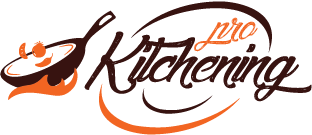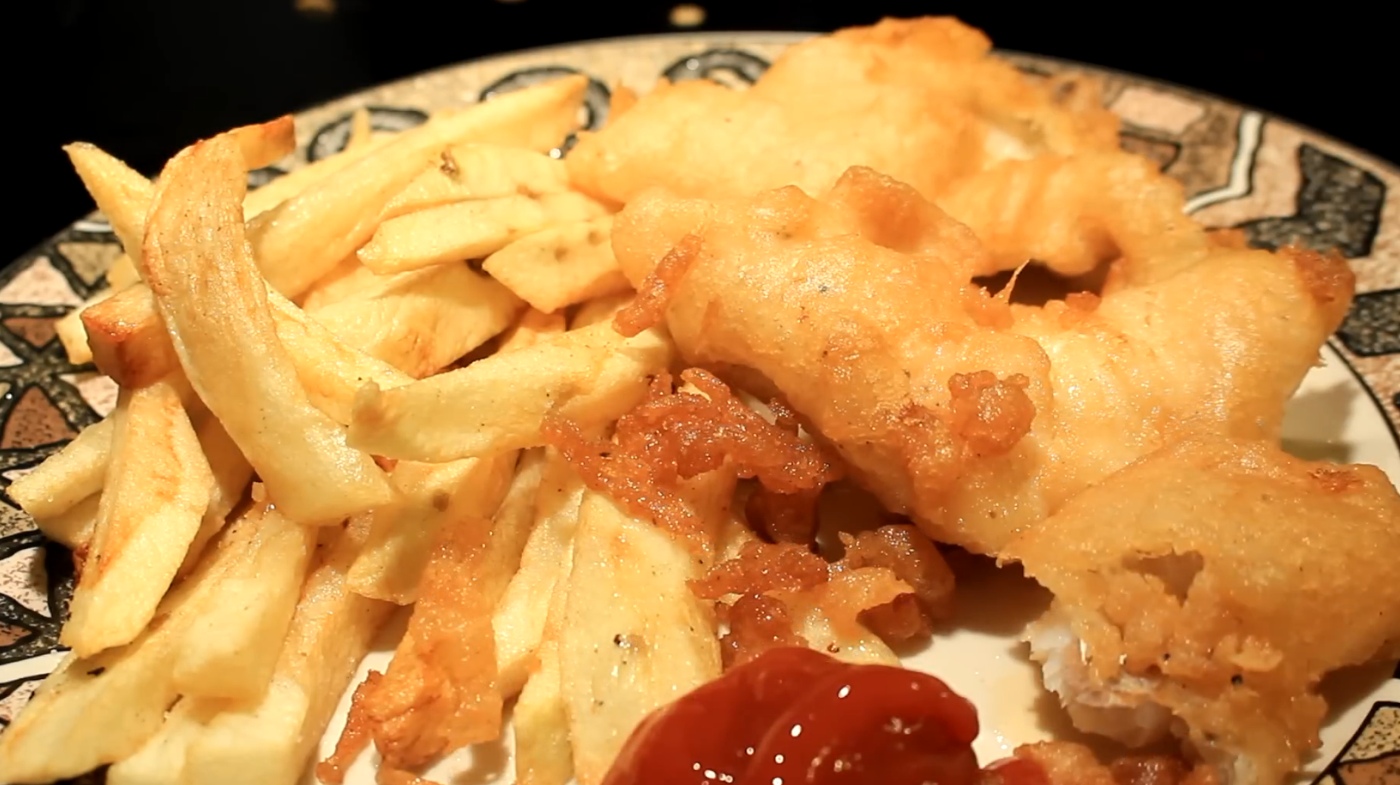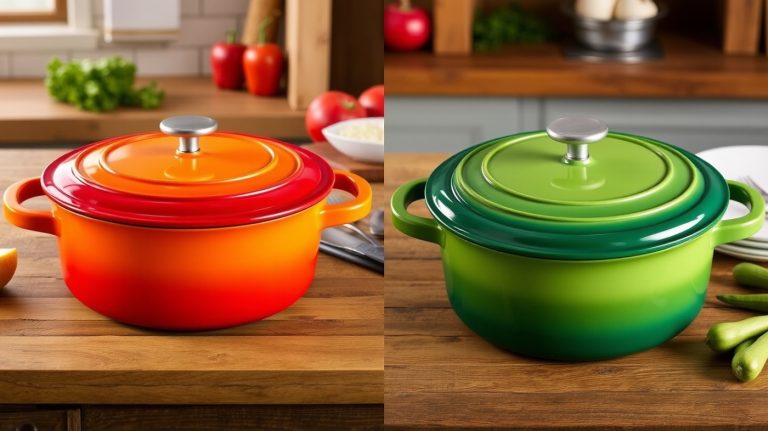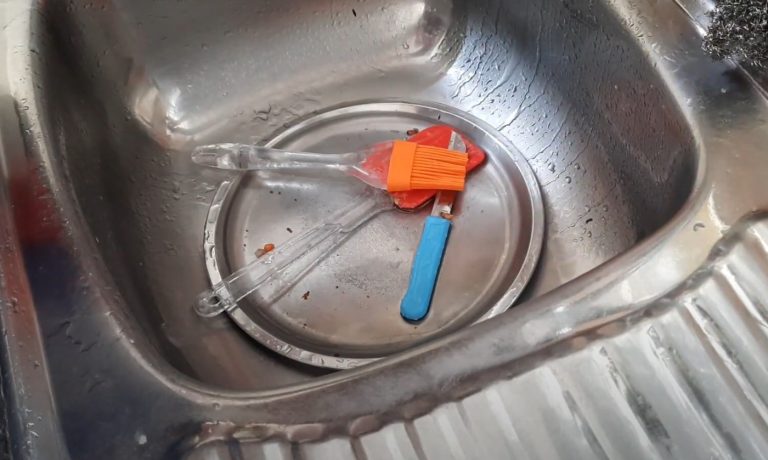Long John Silvers Fish Batter Recipe: The Ultimate Guide
To recreate Long John Silver’s fish batter, combine all-purpose flour with cornstarch for light crispiness, and add baking powder plus baking soda for puffiness.
Mix in cold club soda gradually to activate leavening and achieve a smooth, aerated batter. Use firm white fish like cod, keep oil at 350°F, and avoid overcrowding for even frying.
This precise method yields a perfectly crispy texture with balanced flavor—exploring further reveals detailed seasoning and frying tips to perfect your dish.
Key Takeaways
- Long John Silver’s fish batter combines all-purpose flour, cornstarch, baking powder, and baking soda for a light, crispy texture.
- The batter includes salt, sugar, and seasonings like paprika and onion powder for balanced flavor and golden browning.
- Cold club soda or sparkling water is used to create aeration and activate leavening agents for a puffy, crispy coating.
- Fish fillets are patted dry and dipped in the batter before frying at a steady 350°F to ensure crispiness without greasiness.
- Maintaining oil temperature and draining fish on a wire rack prevents sogginess, replicating the signature Long John Silver’s crunch.
At a Glance: Long John Silvers Batter Recipe Breakdown
| Ingredients | Process |
|---|---|
| 2 cups all-purpose flour | Combine with cornstarch to form the base structure of the batter. |
| ½ cup cornstarch | Adds a light, crispy texture when fried. |
| 1 tbsp baking powder | Works with baking soda to create leavening, making the batter puff up. |
| ½ tsp baking soda | Activates with acid and carbonation to introduce airiness. |
| 1 tsp salt | Enhances the overall flavor of the batter. |
| 1 tbsp granulated sugar | Helps with browning and adds a slight touch of sweetness. |
| ½ tsp paprika | Provides a subtle color and smoky undertone. |
| ½ tsp onion powder | Adds a light, savory depth of flavor. |
| ¼ tsp garlic powder | Optional, for a gentle umami kick. |
| ¼ tsp ground black pepper | Gives the batter a mild spiced balance. |
| 1½ – 2 cups cold club soda (or sparkling water) | Gradually add to dry mix while stirring to create a smooth, foamy batter. Helps activate leavening and keeps the batter light and bubbly. |
| White fish fillets (cod, haddock, etc.) | Use firm, white-fleshed fish; pat them dry before dipping into the batter. Cod works best for an authentic taste and texture. |
| High smoke point oil (canola or peanut) | Heat oil to 350°F and maintain it steadily for crisp, non-greasy frying. |
Ingredients for Long John Silver’s Fish Batter
To replicate Long John Silver’s fish batter, you’ll need a carefully balanced combination of dry ingredients, seasonings, and liquids that work together to create a crisp, airy coating.
Start with all-purpose flour as the structural base and add cornstarch for crispiness. Incorporate baking powder and baking soda to generate leavening, ensuring puffiness and light texture. Salt enhances flavor, while granulated sugar aids browning.
Use all-purpose flour and cornstarch for crispiness, with baking powder and soda for light, puffy texture.
Seasonings like onion powder, paprika, garlic powder, and black pepper contribute subtle savory notes and color, though some recipes omit these for simplicity.
For liquids, use club soda or sparkling water to introduce effervescence, lightening the batter and activating leavening. Water is a viable alternative, but the liquid-to-dry ratio typically stays near 3/4 to 1 cup per 2 cups dry mix for ideal consistency.
This recipe uses cold tap water which is sufficient and requires no additional carbonation to achieve a light batter.
Preparing the Batter Mix
Start by thoroughly combining your dry ingredients—flour, cornstarch, baking powder, baking soda, salt, sugar, and seasonings—to guarantee an even distribution and eliminate lumps.
Sift or stir these components meticulously to ensure uniformity, which is critical for consistent leavening and flavor.
Next, gradually incorporate cold club soda, stirring continuously to activate the leavening agents and promote carbonation. This controlled integration prevents gluten overdevelopment, preserving batter lightness.
The carbonation in club soda creates air bubbles, resulting in an airy, crispy coating that elevates the texture. Achieve a smooth, aerated batter with visible foam bubbles, indicating ideal texture for frying.
Maintain a ratio near 2 cups dry mix to 16 ounces liquid for proper thickness—thick enough to coat fish evenly but not so dense as to impede crispness. Keep the batter cold before use to further enhance frying performance and final texture.
Choosing the Right Fish for Frying
When selecting fish for frying, you should prioritize firm, white-fleshed varieties that maintain structural integrity under high heat and complement the batter’s flavor profile.
Cod and haddock stand out: cod offers dense, neutral-flavored fillets that highlight batter seasoning, while haddock provides a flakier texture with a slightly stronger fish taste.
Pollock and tilapia serve as cost-effective alternatives but require careful handling due to softer flesh. Avoid oily or fatty fish like salmon, which break down and produce excess grease when fried.
Ascertain fillets are thick-cut and patted dry to enhance batter adhesion and crispness. Smaller fish like smelts and sardines offer unique fried options but demand different preparation.
Ultimately, your choice should balance texture, flavor neutrality, and availability to optimize frying performance and final dish quality.
Frying Techniques and Temperature Control
You need to maintain oil at a steady 350°F to achieve a crisp, golden batter without excess oil absorption. Avoid overcrowding the fryer, as it causes temperature drops that lead to soggy fish. Use a thermometer and add fish gradually to keep the oil temperature stable throughout frying.
Ideal Oil Temperature
Although achieving the ideal oil temperature requires careful attention, maintaining a steady 350°F is essential for frying Long John Silver’s fish batter to perfection.
At this temperature, the batter crisps quickly to a golden brown without absorbing excess oil, ensuring a light, airy texture. The batter can be made up to 1 day in advance to preserve its freshness of flavor while preparing other ingredients.
You must monitor temperature precisely with a digital thermometer and adjust heat incrementally to avoid sogginess or burning. Keep oil depth sufficient for even heat distribution and wait for the oil to reheat to 350°F between batches.
Follow these key practices:
- Gradually lower fish to prevent temperature spikes and splatter.
- Avoid overcrowding to maintain consistent heat.
- Remove batter debris to stabilize temperature.
- Observe golden crust formation and floating fish as temperature indicators.
Fryer Capacity Tips
Maintaining a steady 350°F oil temperature hinges not only on heat control but also on managing fryer capacity effectively. Overcrowding your fryer lowers oil temperature rapidly, causing soggy, greasy batter and uneven cooking.
To make sure the batter coats the fish properly, mix gently to maintain bubbles in the batter, which helps achieve a light and crispy texture.
To avoid this, fill your fryer to no more than one-third to one-half capacity, allowing fish pieces enough space to float and crisp evenly.
Use a deep fryer or heavy pot with sufficient oil volume—at least 8 cups—to provide thermal mass, stabilizing temperature during batch frying. Ensuring proper heat distribution in the oil is key to consistent frying results.
Employ frying baskets or tongs to maneuver fish without damaging the batter. Spread pieces evenly and add new batches only after oil temperature fully recovers. Monitor fish color and floatation as indicators that batch size and technique maintain ideal frying conditions.
Avoiding Oil Temperature Drops
Three key frying techniques help you avoid oil temperature drops that compromise batter texture and fish doneness.
Maintaining oil between 350°F and 400°F guarantees ideal cooking without excessive oil absorption or burning. Preheat oil to 375°F before frying to minimize temperature shock. Using high smoke point oils such as peanut or canola oil ensures the oil remains stable at frying temperatures.
Control batch size carefully; frying too many pieces at once causes rapid temperature decline and uneven cooking. Keep fish dry to reduce steam-induced heat loss, patting it thoroughly before battering.
- Preheat oil to target temperature (375°F) before frying.
- Fry small, evenly sized batches to prevent temperature drops.
- Pat fish dry to minimize moisture-related oil cooling.
- Use a reliable thermometer for continuous temperature monitoring and adjust heat promptly.
Achieving the Perfect Crispy Texture
When you aim for the perfect crispy texture in Long John Silver’s fish batter, understanding the precise balance of ingredients and frying conditions is crucial.
Combine all-purpose flour with cornstarch to create a sturdy yet light base. Incorporate baking soda and baking powder in exact ratios to generate leavening that puffs the batter, while using cold club soda introduces carbonation for added crispness.
Maintain batter viscosity to guarantee even coating without dripping. Fry fish at a steady 350°F, lowering it gently to prevent batter damage and avoid overcrowding to keep oil temperature stable.
After frying, drain on a wire rack to prevent steam softening. Sifting dry ingredients and stirring continuously while mixing preserves batter smoothness and activates leavening, all critical for achieving that signature airy, crispy crust.
Despite many locations closing, Long John Silver’s remains beloved, with over 500 locations across 38 states still serving their iconic crispy fish.
Flavor Variations and Seasoning Tips
You’ll want to start with classic seasoning blends combining paprika, onion salt, and pepper to replicate Long John Silver’s signature flavor.
Consider incorporating umami enhancers like MSG or natural alternatives to deepen the savory profile without overpowering the batter.
Adjust spice levels and experiment with substitutions to tailor heat and complexity while maintaining balance and even flavor distribution.
Classic Seasoning Blends
Although the base ingredients like flour and cornstarch establish the fundamental texture of Long John Silver’s fish batter, the classic seasoning blends play a critical role in defining its distinctive flavor profile.
You need to balance subtle umami, mild heat, and aromatic notes without overpowering the fish’s delicate taste. Key components include salt for enhancement, baking agents for texture, and spices for depth. Using a stainless steel saucier for mixing can help maintain even heat and prevent sticking during preparation.
- Use onion salt and paprika sparingly (about ½ teaspoon) to add savory complexity and color. The use of club soda as the liquid ingredient contributes to a light and airy batter because of its carbonation, which enhances the overall texture.
- Incorporate black pepper and garlic powder minimally to balance heat and enrich flavor.
- Mix seasonings evenly with dry ingredients before adding liquids to guarantee uniform distribution.
- Maintain precise ratios—too much leavening or sugar alters texture and taste negatively.
Umami Enhancers and MSG
Umami enhancers greatly elevate the savory profile of Long John Silver’s fish batter by intensifying its depth without overshadowing the fish’s natural flavor.
You can integrate natural sources like kombu, dried shiitake mushrooms, and katsuobushi, which contain glutamates and nucleotides that synergistically amplify umami intensity. Using multiple Umami-rich ingredients together enhances the flavor through Umami synergy.
Fermented ingredients—miso, soy sauce, fish sauce—layer complexity while maintaining balance. MSG, a purified form of L-glutamate, efficiently boosts savoriness with minimal sodium and no flavor distortion, though some prefer natural extracts for cleaner labels.
Employing umami synergy—combining multiple glutamate-rich components—produces a more profound and harmonious taste profile than single sources alone.
For consistent results, consider preparing concentrated umami pastes (“flavor bombs”) that blend anchovy, dried shrimp, and tomato paste, then incorporate them sparingly into your batter for enhanced, nuanced savoriness.
Spice Substitutions and Tweaks
When adjusting Long John Silver’s fish batter, selecting the right spice substitutions can greatly alter both flavor and texture without compromising the signature crispness.
You can tailor the batter’s profile by replacing or enhancing key spices and modifying binding agents to maintain ideal crunch and flavor balance.
- Substitute garlic powder for onion salt to intensify aroma, or use smoked paprika for a deeper smoky profile.
- Add cayenne pepper or ground chipotle to increase heat while preserving texture.
- Incorporate dried herbs like thyme or parsley flakes for subtle herbal notes that complement seafood.
- Use cornstarch or rice flour in the seasoning mix to boost crispness and guarantee efficient flavor adherence.
Equipment Needed for Deep Frying
Since deep frying demands consistent heat and safety, selecting the right equipment is crucial for achieving ideal results. You’ll want a fryer with precise temperature control to optimize cooking and extend oil life.
Open-vat fryers suit versatile tasks, while drop-in models save space and simplify cleaning. For high-volume frying, conveyor fryers guarantee consistent throughput.
Commercial deep fryers are essential appliances designed specifically for professional kitchens to deliver optimal frying performance. Many commercial kitchens also integrate energy-efficient designs to help reduce operating costs.
Safety features like automatic shut-off, splash guards, and cool-touch handles minimize risk. Efficient heating elements reduce cooking time, boosting productivity.
Managing oil quality requires filter cones, test kits for free fatty acids, and heat-resistant gloves. Cleaning tools—including brushes, drain rods, and crumb scoops—maintain fryer performance and safety.
Finally, choose between electric or gas fryers based on your kitchen’s infrastructure and energy efficiency needs, guaranteeing reliable and economical operation.
Serving Suggestions and Nutritional Information
After selecting and managing the proper frying equipment, understanding the nutritional profile and ideal serving options for Long John Silver’s battered fish helps you optimize both flavor and dietary balance.
Each 3 oz serving delivers 190-230 calories, 15 g protein, and 10.6-16 g fat, with sodium levels ranging 560-790 mg, necessitating mindful intake. These values contribute to your daily diet based on a general 2,000 calorie guideline, but individual needs may vary depending on your energy requirements.
To enhance your meal while managing nutrition, consider these points:
- Pair with vegetables or salads to increase fiber and micronutrient intake.
- Limit high-fat, high-sodium sides like fries or hush puppies to control cardiovascular risk.
- Choose water or low-calorie beverages to avoid extra sugars and calories.
- Adjust portion size and preparation methods to align with dietary goals, especially for low-carb or sodium-restricted diets.
Frequently Asked Questions
Can I Make the Batter Gluten-Free?
Yes, you can make batter gluten-free by substituting traditional wheat flour with alternatives like rice flour, potato starch, or tapioca starch.
Use gluten-free baking powder and soda to maintain leavening. Incorporate cold club soda to enhance aeration.
Adjust batter viscosity for proper coating and monitor frying temperature closely to prevent rapid browning.
Testing small batches helps optimize texture and crispiness, ensuring a safe, gluten-free, and appealing result tailored to your needs.
How Long Can Leftover Batter Be Stored?
You’ll want to treat leftover batter like a delicate guest—it’s happiest fresh and reluctant to linger.
Technically, you can store batter with water added for up to 24 hours in an airtight container under refrigeration at 41°F or below.
Beyond that, the batter’s leavening agents lose potency, and texture degrades, making it less effective for frying.
For best results, prepare fresh batter each time to guarantee ideal crispness and safety.
Is It Possible to Bake Instead of Fry the Battered Fish?
You can bake battered fish instead of frying it, but expect differences in texture and crispiness.
Baking lacks hot oil immersion, so the crust won’t be as golden or bubbly. To improve results, bake at 400-450°F on a wire rack and spray the batter lightly with oil.
Adjusting batter moisture and adding leavening agents can help, though baking typically produces a denser, less crispy crust than frying.
What Oil Is Best for Reuse After Frying?
You’ll want to choose oils with high smoke points and neutral flavors for reuse after frying, like canola or vegetable oil.
These oils withstand repeated high-heat exposure (375-450°F) without breaking down quickly.
After frying, cool the oil, strain out particles, and store it sealed in a cool, dark place.
Avoid oils like olive oil, which degrade faster and carry strong flavors.
Limit reuse to 3-4 times to maintain safety and quality.
Can This Batter Recipe Be Used for Other Seafood?
Just as a versatile Swiss Army knife adapts to many tasks, this batter excels beyond white fish, suiting shrimp, scallops, and calamari with its light, crispy texture.
The blend of cornstarch and leavening agents, combined with club soda’s aeration, creates a golden crust perfect for deep frying.
Bringing It All Together: The Secret to Crispy, Golden Perfection
By blending basic batter basics with balanced, bold seasoning, you’ll build better bites bursting with brilliance. Carefully controlling cooking temperatures and choosing crisp, cold fish creates consistently crispy, crave-worthy crusts.
Mastering methods and maintaining meticulous measurements means maximizing mouthwatering mastery every time. Whether frying for family or friends, this focused formula fuels flavorful finesse flawlessly.
Embrace equipment essentials and experiment with enhancements to elevate your Long John Silver’s fish batter, ensuring exceptional, enjoyable eating experiences.







